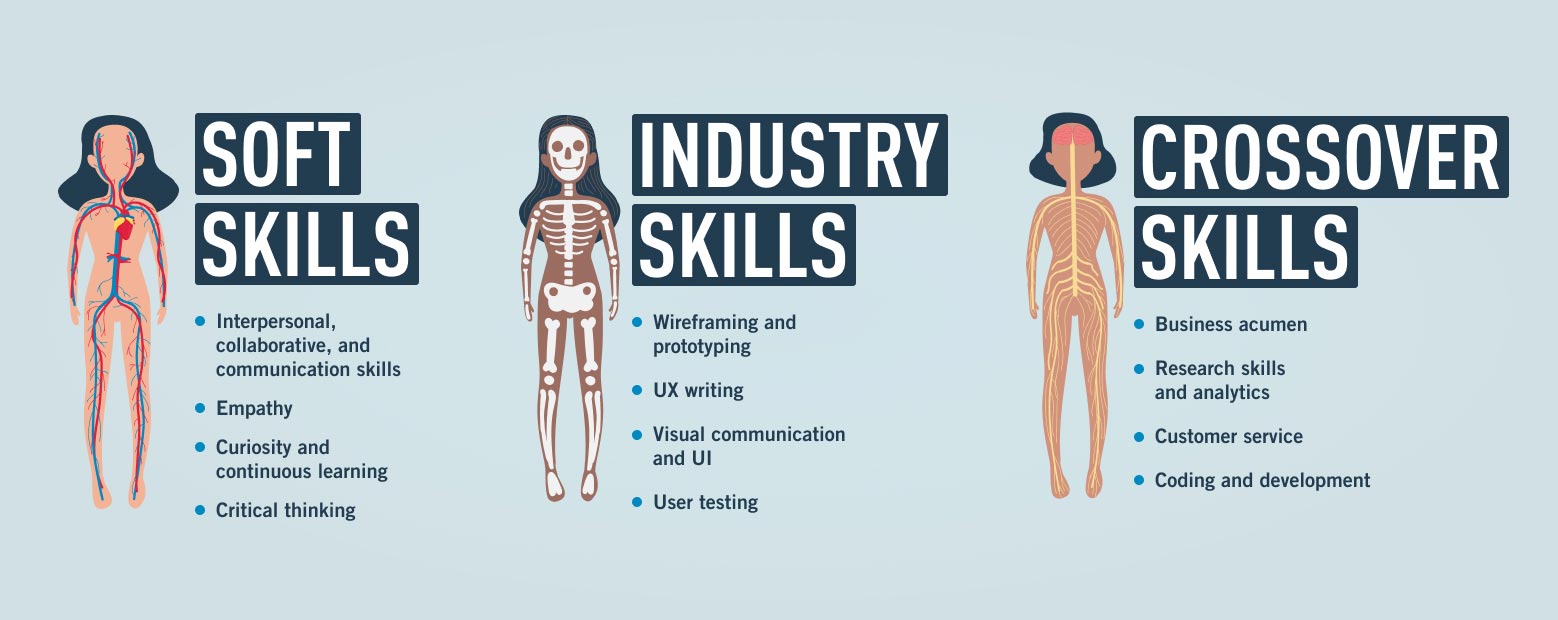UX designer is a pretty popular job right now. And that popularity is only growing: CNN has reported that the number of UX design positions is likely to rise by 18% by 2028.
The job site, Indeed, named the user experience designer role as one of the top 25 jobs for work-life balance, and a study by the Nielsen Norman Group found that UX designers truly love their work.
So it’s no surprise people are wondering how to become a UX designer: and if they need a UX designer qualification.
As a dynamic, creative discipline that continues to grow and change, there is no clear consensus on which qualifications are required to work in the field. Before looking into a career in UX design, many assume any career with the word ‘designer’ in the title requires an art school degree.
However, very few UX designers studied UX at university. Instead, they come from a wide range of different backgrounds, from psychology and marketing to project management and finance.
In this article, we’ll unpack what qualifications you’ll need to become a UX designer. Here’s what we’ll cover:
- Do I need a degree to become a UX designer?
- How do I get into UX design?
- How do I know if I have the skills to make a good UX designer?
- How will studying for a UX design qualification help me?
- What will a UX qualification not help with?
- How do I find out if UX design is right for me?
- Final thoughts
- FAQ about UX design education requirements
Ready? Let’s dive right in!
1. Do I need a degree to become a UX designer?
It’s a common misconception that technology-related qualifications, or a solid background in tech, are prerequisites for landing a job in the field. Many assume employers won’t give the time of day to a candidate without a relevant UX designer degree.
The truth is, you don’t need a college degree to break into the world of tech. In fact, many career-changers have found that UX bootcamps are an effective and worthwhile means of kickstarting a new career, and these don’t carry any UX designer education requirements.
2. So how do I get into UX design?
If you are really determined, you could teach yourself UX design by reading blogs and books about UX, listening to podcasts, or learning on the job. It really depends on how much relevant experience you have and whether you would be able to demonstrate your ability in an interview without having a UX designer qualification to back you up.
In the following video, professional UX designer Maureen Herben outlines the steps you should follow to get into UX design, based on her own career-change experience:
You can also take a free UX short course or find a UX certification program that will immerse you fully in the world of UX.
However, if you are the average person prone to procrastination, you will be likely to benefit from a course with a structured learning environment, where you have an allotted amount of time to complete it and, importantly, regular contact with a mentor or tutor.
Having a mentor doesn’t only afford you the insights and expertise of a seasoned professional—it also helps keep you motivated and accountable in those inevitable moments when you question or doubt yourself and the decision to become a UX designer.
In terms of which structured course to take, again, there are lots of different options. General Assembly is probably the most famous. Providers such as Akendi offer classroom-based week-long short courses—although it is pretty tricky to learn everything there is to know about UX in one week.
Then, of course, there’s the CareerFoundry UX Design Program, which gives you the best of both worlds – you have the convenience of studying at home as well as frequent catch-up video calls with a mentor. Read this article for a deeper dive into the many options you have for how to get structured online UX design training.
3. How do I know if I have the skills to make a good UX designer?

The skills needed for UX are really varied. Most people are surprised that user experience design is less about being a stereotypically creative type and much more about soft skills like communication, organization, and critical thinking.
Obviously, you need to be comfortable conducting user research, visualizing user journeys, and wireframing (and more UX-specific processes and technical skills), but it is more important to have skills like empathy, enthusiasm, time management, and the ability to negotiate. Strong awareness of how businesses work is critical too, especially being able to ask the right questions to elicit answers around what the client is trying to achieve.
But the most important character trait of all is a keen interest in problem-solving.
CareerFoundry itself was created in order to solve a problem that the founder, Raffaela Rein, had experienced. She wanted to move out of banking and into tech but couldn’t find a course that suited her needs. UX professional Sarah Doody also recommends looking for problems in your everyday life to help hone your problem-solving skills.
4. How will studying for a UX design qualification help me?
There are many benefits to a UX design degree or other advanced qualification, such as:
- Learning the core concepts and elements of the UX design process. You don’t know what you don’t know—so a structured training program provides instruction and guidance from people who have years of UX experience and a good understanding of what you need to know as a UX beginner.
- A UX design program will give you a great network of people to surround yourself with—your mentor, tutor, fellow students, and career-changers, for example. I’m still in contact with Sophie, my mentor from CareerFoundry, who has been fantastic at introducing me to other people in the UX industry. She put me in touch with her old boss when I moved to New Zealand and also keeps me informed on interesting UX reading.
- A good UX design program will help you build a strong professional portfolio. Portfolios are a requirement for most UX job interviews, so a project-based program will give you time and guidance as you build and refine your UX portfolio.
- While there are likely few jobs that will have UX designer education requirements, a program will help you get your first interview if you don’t have any prior job experience. Once you have a couple of years of UX experience under your belt, you’ll find people aren’t really concerned about you having a UX design qualification anymore.
5. What will a UX design qualification not help with?
The one main thing that a UX design qualification won’t help you with is feeling like you know it all. You won’t wake up the day after completing the course and suddenly feel like you know everything—a UX designer will never know everything, and imposter syndrome is a common reality among new UXers.
Remember that the role of a UX designer is constantly evolving, and it really comes down to how you keep up to date with new technologies and trends, and continuously study UX advances.
Think of the qualification as the starting point of an exciting journey of UX discovery and as you get more experienced, you will become more and more confident. A lot of your skill will come with experience, but that’s not to say you can’t speed up the process by learning from the experience of others.
If you want to know more about what it means in practice to be a UX designer, check out my blog post on what a UX designer actually does.
6. How do I find out if UX design is right for me?
It’s a common theme in UX design, but before making any decisions, do your research! This will help you to decide if it is definitely the career for you.
Here are some good ways to test the water before you make your decision:
- Join CareerFoundry’s free 6-day email short course: get a handy introduction to UX and a flavor of what the full UX Design Program is like.
- Start (or keep on) reading: there is a wealth of knowledge on career change and UX here on the CareerFoundry blog.
- Check out social media: Twitter and Medium are both great for finding the latest UX articles and UX experts such as Nick Babich and Sarah Doody have great weekly newsletters with handpicked articles. Sarah’s newsletters also have handy trigger questions to help you start thinking like a UX designer.
- Speak to people in the UX industry and go to networking events. Check out this blog post on networking in UX design for more tips.
It can also help to talk to other designers! If you don’t already have some in your network, reach out to UX designers on LinkedIn and find out the lessons they learned after they broke into the field. And if you’re an aspiring UXer in your 40s, 50s, 60s, or wiser, and you’re concerned about age being a problem, here’s one for you: Are you too old to start a career in UX? (spoiler alert: the answer is no).
7. Final thoughts
Clearly, UX design is an exciting and rewarding career path, with many different routes to take to enter the field; and there’s certainly no hard-and-fast UX designer education requirement.
Finding the right way to go about breaking into the career may seem daunting, but with so many options available today, there is sure to be one that meets your needs.
If you’d like to learn more about a career in UX design, check out these articles:
- How to become a UX designer
- What salary will I earn as a UX designer?
- What is the UX design process?
- 5 Tips To Create A Stand-Out UX Writing Portfolio
8. Frequently asked questions (FAQ) about UX design education requirements
1. What education do you need to be a UX designer?
While formal education requirements for UX designers can vary, a bachelor’s degree in a relevant field such as graphic design, interaction design, psychology, or computer science is commonly preferred by employers.
However, it’s worth noting that practical experience, a strong portfolio demonstrating design skills, and proficiency in UX design tools and methodologies can be equally important in the field.
2. Does UX design require coding?
UX design itself does not necessarily require coding proficiency. However, having a basic understanding of coding languages like HTML, CSS, and JavaScript can be beneficial for UX designers. It allows them to effectively collaborate with developers, understand technical constraints, and prototype interactive designs.
While coding skills are not mandatory for all UX designers, they can be advantageous in certain situations or job roles.
3. How hard is it to become a UX designer?
The difficulty of becoming a UX designer can vary depending on an individual’s background, skills, and dedication to learning. Transitioning into UX design typically requires a combination of design thinking, user research, prototyping, and usability testing skills.
While it may not be the easiest field to break into, with determination, continuous learning, and practical experience gained through projects or internships, it is certainly achievable for motivated individuals.
4. Is a UX design degree worth it?
The value of a UX design degree depends on various factors, including individual career goals, prior experience, and the specific program’s quality and reputation. While a degree can provide a solid foundation in design principles and user-centered methodologies, it’s not the only path to a successful career in UX design.
Building a strong portfolio, gaining practical experience, and continuously improving skills through bootcamps, self-study, and networking can also be valuable. Ultimately, the decision to pursue a UX design degree should be based on individual circumstances and long-term career aspirations.

